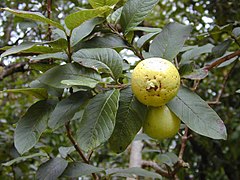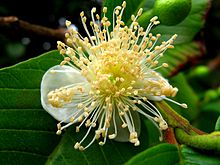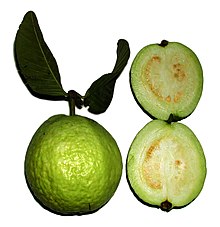Guava
This article includes a list of general references, but it lacks sufficient corresponding inline citations. (August 2010) |
| Guava | |
|---|---|

| |
| Apple Guava (Psidium guajava) | |
| Scientific classification | |
| Kingdom: | |
| Division: | |
| Class: | |
| Subclass: | |
| Order: | |
| Family: | |
| Subfamily: | |
| Tribe: | |
| Genus: | Psidium |
| Species | |
|
About 100, see text | |
| Synonyms | |
|
Calyptropsidium O.Berg | |
Guavas (singular Guava, /ˈgwɑː.və/[2]) are plants in the Myrtle family (Myrtaceae) genus Psidium (meaning "pomegranate" in Latin),[3] which contains about 100 species of tropical shrubs and small trees. They are native to Mexico, Central America, and northern South America. Guavas are now cultivated and naturalized throughout the tropics and subtropics in Africa, South Asia, Southeast Asia, the Caribbean, subtropical regions of North America, and Australia.
Types
The most frequently encountered species, and the one often simply referred to as "the guava", is the Apple Guava (Psidium guajava).[citation needed]
Guavas are typical Myrtoideae, with tough dark leaves that are opposite, simple, elliptic to ovate and 5–15 centimetres (2.0–5.9 in) long. The flowers are white, with five petals and numerous stamens.
The genera Accara and Feijoa (= Acca, Pineapple Guava) were formerly included in Psidium.[citation needed]
Common names

The term "guava" appears to derive from Arawak guayabo "guava tree", via the Spanish guayaba. It has been adapted in many European and Asian languages, having a similar form.
Another term for guavas is salmon skin, derived from pear. It is common around the western Indian Ocean and probably derives from Spanish or Portuguese. In some Middle-Eastern regions, guava is also called amrood, possibly a variant of armoot meaning "pear" in Arabic and Turkish languages.
Ecology

Psidium species are used as food plants by the caterpillars of some Lepidoptera, mainly moths like the Ello Sphinx (Erinnyis ello), Eupseudosoma aberrans, E. involutum, and Hypercompe icasia. Mites like Pronematus pruni and Tydeus munsteri are known to parasitize the Apple Guava (P. guajava) and perhaps other species. The bacterium Erwinia psidii causes rot diseases of the Apple Guava.
The fruit is not only relished by humans, but by many mammals and birds as well. The spread of introduced guavas owes much to this fact, since animals eat the fruit and disperse the seeds in their droppings.
In several tropical regions, including Hawaii, some species (namely Strawberry Guava, P. littorale, and to a lesser extent Apple Guava) have become invasive species. On the other hand, several species have become very rare due to habitat destruction and at least one (Jamaican Guava, P. dumetorum), is already extinct.
Guava wood is used for meat smoking in Hawaii and is used at barbecue competitions across the United States. In Cuba and Mexico the leaves are used in barbecues.

Fruit

Guava fruit, usually 4 to 12 centimetres (1.6 to 4.7 in) long, are round or oval depending on the species. The outer skin may be rough, often with a bitter taste, or soft and sweet. Varying between species, the skin can be any thickness, is usually green before maturity, but becomes yellow, maroon, or green when ripe.
Guava fruit generally have a pronounced and typical fragrance, similar to lemon rind but less sharp. Guava pulp may be sweet or sour, tasting something between pear and strawberry, off-white ("white" guavas) to deep pink ("red" guavas), with the seeds in the central pulp of variable number and hardness, depending on species.
Range
Guavas are cultivated in many tropical and subtropical countries. Several species are grown commercially; apple guava and its cultivars are those most commonly traded internationally.

Mature trees of most species are fairly cold-hardy and can survive temperatures slightly colder than 25 °F (−4 °C) for short periods of time, but younger plants will likely freeze to the ground.[4]

Guavas are also of interest to home growers in temperate areas. They are one of the few tropical fruits that can grow to fruiting size in pots indoors. When grown from seed, guavas can bear fruit as soon as two years, or as long as eight years.
Culinary uses
In Hawaii, guava is eaten with soy sauce and vinegar. Occasionally, a pinch of sugar and black pepper are added to the mixture. The fruit is cut up and dipped into the sauce.
In Mexico, the Agua fresca beverage is popularly made with Guava. The entire fruit is a key ingredient in punch, and the juice extract is often used in culinary sauces (hot or cold), as well as artisan candies, dried snacks, fruit bars, desserts, or dipped in Chamoy. Pulque de Guava is a popular blend of the native alcoholic beverage.
In Nepal, Pakistan and India, guava is often eaten raw, typically cut into quarters with a pinch of salt and pepper and sometimes cayenne powder/masala. In Pakistan it is known as the winter National fruit of Pakistan.
In the Philippines, ripe guava is used in cooking sinigang.
Guava is a very popular snack in Taiwan, sold on many street corners and night markets during hot weather. In Taiwan, China, and some other parts of east Asia, guava is very commonly eaten with sweet or sweet and sour dried plum powder mixtures.
Guava juice is very popular in Cuba, Costa Rica, Egypt, Mexico, Colombia, Hawaii, Puerto Rico, Venezuela, Malaysia,Indonesia and South Africa.
The fruit is also often prepared as a dessert, in fruit salads. In Asia, fresh guava slices are often dipped in preserved prune powder or salt. In India it is often sprinkled with red rock salt, which is very tart.
Because of its high level of pectin, guavas are extensively used to make candies, preserves, jellies, jams, and marmalades (such as Brazilian goiabada and Colombian and Venezuelan bocadillo), and also for juices and aguas frescas.may be used in a marmalade jam for toast.
"Red" guavas can be used as the base of salted products such as sauces, substituting for tomatoes, especially for those sensitive to the latter's acidity. In Asia, a drink is made from an infusion of guava fruits and leaves. In Brazil, the infusion made with guava tree leaves (chá-de-goiabeira, i.e. "tea" of guava tree leaves) is considered medicinal.

Nutritional value
Guavas are rich in dietary fiber, vitamins A and C, folic acid, and the dietary minerals, potassium, copper and manganese. Having a generally broad, low-calorie profile of essential nutrients, a single common guava (P. guajava) fruit contains about four times the amount of vitamin C as an orange.[5]
However, nutrient content varies across guava cultivars. Although the strawberry guava (P. littorale var. cattleianum) has about 25% of the amount found in more common varieties, its total vitamin C content in one serving (90 mg) still provides 100% of the Dietary Reference Intake for adult males.[6]

Guavas contain both carotenoids and polyphenols like (+)-gallocatechin,[7] guaijaverin, leucocyanidin and amritoside[8]–the major classes of antioxidant pigments – giving them relatively high potential antioxidant value among plant foods.[9] As these pigments produce the fruit skin and flesh color, guavas that are red-orange have more pigment content as polyphenol, carotenoid and pro-vitamin A, retinoid sources than yellow-green ones.[10]

| Common Guava, per 165 g of individual fruit portion | |
|---|---|
| Calories | 112 |
| Moisture | 133 g |
| Dietary Fiber | 8.9 g (36%) |
| Protein | 4.2 g (8%) |
| Fat | 1.6 g (2%) |
| Ash | 2.3 g |
| Carbohydrates | 23.6 g (8%) |
| Calcium | 30 mg (3%) |
| Phosphorus | 66 mg (7%) |
| Iron | 0.4 mg (2%) |
| Potassium | 688 mg (20%) |
| Copper | 0.4 mg (19%) |
| Beta-carotene (Vitamin A) | 1030 IU (21%) |
| Ascorbic acid (Vitamin C) | 377 mg (628%) |
| Thiamin (Vitamin B1) | 0.1 mg (7%) |
| Riboflavin (Vitamin B2) | 0.1 mg (4%) |
| Niacin (Vitamin B3) | 1.8 mg (9%) |
| Folic acid | 81 mcg (20%) |
% Daily Value in parentheses. Nutrient data source: US Department of Agriculture National Nutrient Database from Nutritiondata.com
Potential medical uses
This section needs more reliable medical references for verification or relies too heavily on primary sources. (September 2012) |  |
Since the 1950s, guavas – particularly the leaves – have been the subject for diverse research on their constituents, pharmacological properties and history in folk medicine.[11] Most research, however, has been conducted on apple guava (P. guajava), with other species remaining unstudied. From preliminary medical research in laboratory models, extracts from apple guava leaves or bark are implicated in therapeutic mechanisms against cancer, bacterial infections, inflammation and pain.[12][13][14] Essential oils from guava leaves display anti-cancer activity in vitro.[15]
Guava leaves are used in folk medicine as a remedy for diarrhea[16] and, as well as the bark, for their supposed antimicrobial properties and as an astringent. Guava leaves or bark are used in traditional treatments against diabetes.[17][18][19] In Trinidad, a tea made from young leaves is used for diarrhea, dysentery and fever.[20]
Selected species



|
|
Formerly placed here
- Acca macrostema (as P. macrostemum
- Campomanesia adamantium (as P. adamantium Cambess.)
- Campomanesia aromatica (as P. aromatica Aubl.)
- Campomanesia grandiflora (as P. grandiflorum Aubl.)
- Campomanesia guaviroba (as P. cerasoides Cambess. or P. guaviroba DC.)
- Campomanesia lineatifolia (as P. rivulare DC.)
- Campomanesia pubescens (as P. corymbosum Cambess., P. obversum Miq. or P. pubescens
- Eugenia salamensis var. rensoniana (as P. rensonianum Standl.)
- Myrciaria dubia (as P. dubium Kunth)[21]

See also
- Leslie R. Landrum, guava botanist
Footnotes
- ^ a b "Genus: Psidium L." Germplasm Resources Information Network. United States Department of Agriculture. 2009-01-27. Retrieved 2010-03-03.
- ^ "Cambridge Advanced Learner's Dictionary & Thesaurus". Cambridge University Press. Retrieved 20 August 2012.
- ^ Quattrocchi, Umberto (2000). CRC World Dictionary of Plant Names. Vol. III M-Q A-C. CRC Press. p. 2203. ISBN 978-0-8493-2677-6.
- ^ Julian W. Sauls (December 1998). "HOME FRUIT PRODUCTION-GUAVA". Texas A&M Horticulture program. Retrieved 2012-04-17.
- ^ Nutritiondata.com. "Nutrition facts for common guava". Retrieved August 17, 2010.
{{cite web}}: Cite has empty unknown parameter:|source=(help) - ^ Nutritiondata.com. "Nutrition facts for strawberry guava". Retrieved August 17, 2010.
{{cite web}}: Cite has empty unknown parameter:|source=(help) - ^ Identification of (+)-gallocatechin as a bio-antimutagenic compound in Psidium guava leaves. Tomoaki Matsuo, Norifumi Hanamure, Kayoko Shimoi, Yoshiyuki Nakamura and Isao Tomita, Phytochemistry, Volume 36, Issue 4, July 1994, Pages 1027-1029, doi:10.1016/S0031-9422(00)90484-9
- ^ Polyphenols of the leaves of psidium guava—quercetin, guaijaverin, leucocyanidin and amritoside. T.R. Seshadri and Krishna Vasishta, Phytochemistry, Volume 4, Issue 6, 1965, Pages 989-992, doi:10.1016/S0031-9422(00)86281-0
- ^ Jiménez-Escrig et al. (2001), Hassimotto et al. (2005), Mahattanatawee et al. (2006)
- ^ Wrolstad (2001)
- ^ Gutiérrez et al. (2008)
- ^ Ojewole (2006)
- ^ Chen et al. (2007)
- ^ Mahfuzul Hoque et al. (2007)
- ^ Manosroi et al. (2006)
- ^ Kaljee et al. (2004)
- ^ Oh et al. (2005)
- ^ Mukhtar et al. (2006)
- ^ (free registration required) Anti-Hyperglycemic and Anti-Hyperlipidemic Effects of Guava Leaf Extract, Medscape, from Nutrition and Metabolism, Y Deguchi and K Miyazaki, 2010
- ^ Mendes & 1986), p. 65
- ^ a b "GRIN Species Records of Psidium". Germplasm Resources Information Network. United States Department of Agriculture. Retrieved 2011-02-05.
References
- Chen, Kuan-Chou; Hsieh, Chiu-Lan; Peng, Chiung-Chi; Hsieh-Li, Hsiu-Mei; Chiang, Han-Sun; Huang, Kuan-Dar & Peng, Robert Y. (2007): Brain derived metastatic prostate cancer DU-145 cells are effectively inhibited in vitro by guava (Psidium gujava L.) leaf extracts. Nutr. Cancer 58(1): 93–106. HTML abstract
- Gutiérrez, R.M.; Mitchell, S. & Solis, R.V. (2008): Psidium guajava: a review of its traditional uses, phytochemistry and pharmacology. J. Ethnopharmacol. 117(1): 1–27. doi:10.1016/j.jep.2008.01.025 (HTML abstract)
- Hassimotto, N.M.; Genovese, M.I. & Lajolo, F.M. (2005): Antioxidant activity of dietary fruits, vegetables, and commercial frozen fruit pulps. Journal of Agricultural and Food Chemistry 53(8): 2928–2935. doi:10.1021/jf047894h (HTML abstract)
- Healthaliciousness.com [2008]: Nutrient facts comparison for common guava, strawberry guava, and oranges. Retrieved 2008-DEC-21.
- Jiménez-Escrig, A.; Rincón, M.; Pulido, R. & Saura-Calixto, F. (2001): Guava fruit (Psidium guajava L.) as a new source of antioxidant dietary fiber. Journal of Agricultural and Food Chemistry 49(11): 5489–5493. doi:10.1021/jf010147p (HTML abstract)
- Kaljee, Linda M.; Thiem, Vu Dinh; von Seidlein, Lorenz; Genberg, Becky L.; Canh, Do Gia; Tho, Le Huu; Minh, Truong Tan; Thoa, Le Thi Kim; Clemens, John D. & Trach, Dang Duc (2004): Healthcare Use for Diarrhoea and Dysentery in Actual and Hypothetical Cases, Nha Trang, Viet Nam. Journal of Health, Population and Nutrition 22(2): 139-149. PDF fulltext
- Mahattanatawee, K.; Manthey, J.A.; Luzio, G.; Talcott, S.T.; Goodner, K. & Baldwin, E.A. (2006): Total antioxidant activity and fiber content of select Florida-grown tropical fruits. Journal of Agricultural and Food Chemistry 54(19): 7355–7363. doi:10.1021/jf060566s PDF fulltext
- Mahfuzul Hoque, M.D.; Bari, M.L.; Inatsu, Y.; Juneja, V.K. & Kawamoto, S. (2007): Antibacterial activity of guava (Psidium guajava L.) and Neem (Azadirachta indica A. Juss.) extracts against foodborne pathogens and spoilage bacteria. Foodborne Pathogens and Disease 4(4): 481–488. doi:10.1089/fpd.2007.0040 PDF fulltext
- Manosroi, J.; Dhumtanom, P. & Manosroi, A. (2006): Anti-proliferative activity of essential oil extracted from Thai medicinal plants on KB and P388 cell lines. Cancer Letters 235(1): 114–120. doi:10.1016/j.canlet.2005.04.021 PMID 15979235 (HTML abstract)
- Mendes, John (1986). Cote ce Cote la: Trinidad & Tobago Dictionary. Arima, Trinidad.
{{cite book}}: Invalid|ref=harv(help)CS1 maint: location missing publisher (link) - Mukhtar, H.M.; Ansari, S.H.; Bhat, Z.A.; Naved, T. & Singh, P. (2006): Antidiabetic activity of an ethanol extract obtained from the stem bark of Psidium guajava (Myrtaceae). Pharmazie 61(8): 725–727. PMID 16964719 (HTML abstract)
- Oh, W.K.; Lee, C.H.; Lee, M.S. et al. (2005): Antidiabetic effects of extracts from Psidium guajava. J. Ethnopharmacol. 96(3): 411–415. doi:10.1016/j.jep.2004.09.041 (HTML abstract)
- Ojewole, J.A. (2006): Antiinflammatory and analgesic effects of Psidium guajava Linn. (Myrtaceae) leaf aqueous extract in rats and mice. Methods and Findings in Experimental and Clinical Pharmacology 28(7): 441–446. doi:10.1358/mf.2006.28.7.1003578 (HTML abstract)
- Wrolstad, Ronald E. (2001): The Possible Health Benefits of Anthocyanin Pigments and Polyphenolics. Version of May 2001. Retrieved 2008-DEC-21.
External links
![]() Media related to Psidium at Wikimedia Commons
Media related to Psidium at Wikimedia Commons
![]() Data related to Psidium at Wikispecies
Data related to Psidium at Wikispecies
